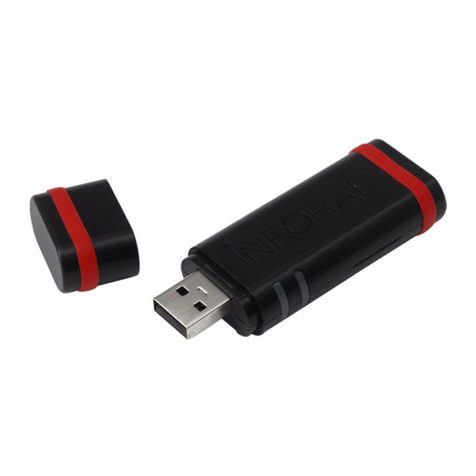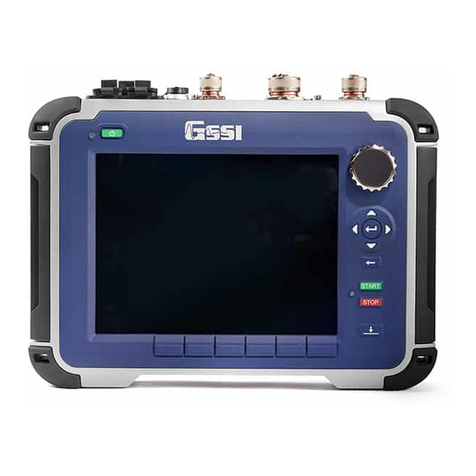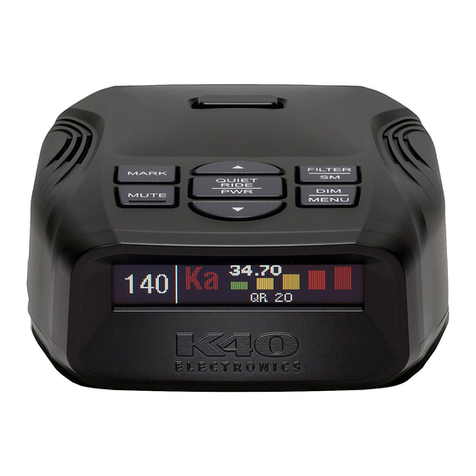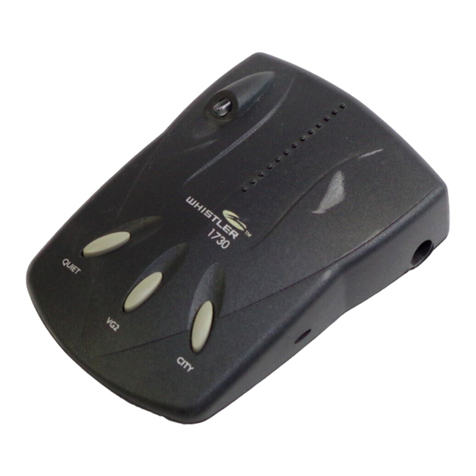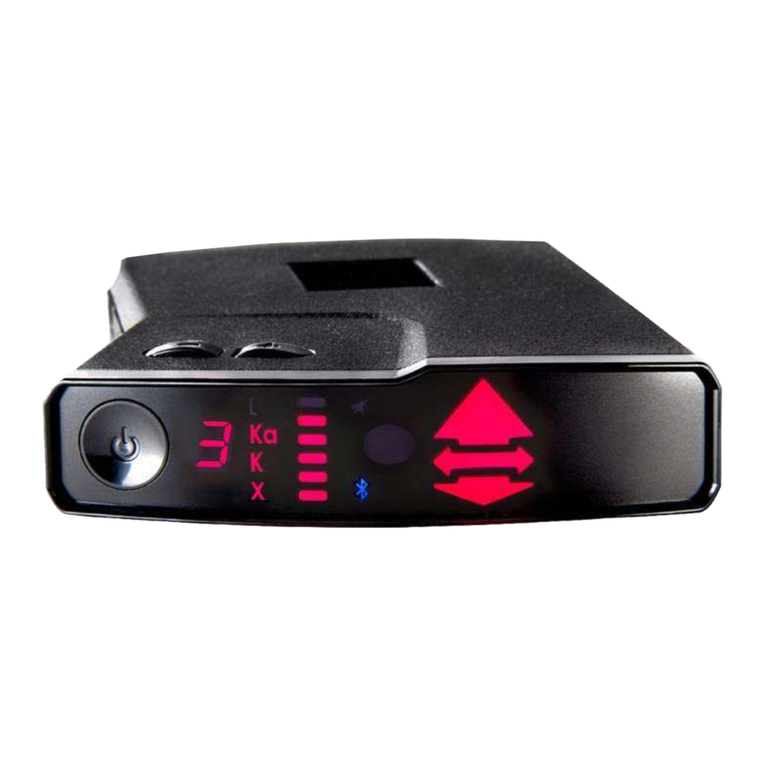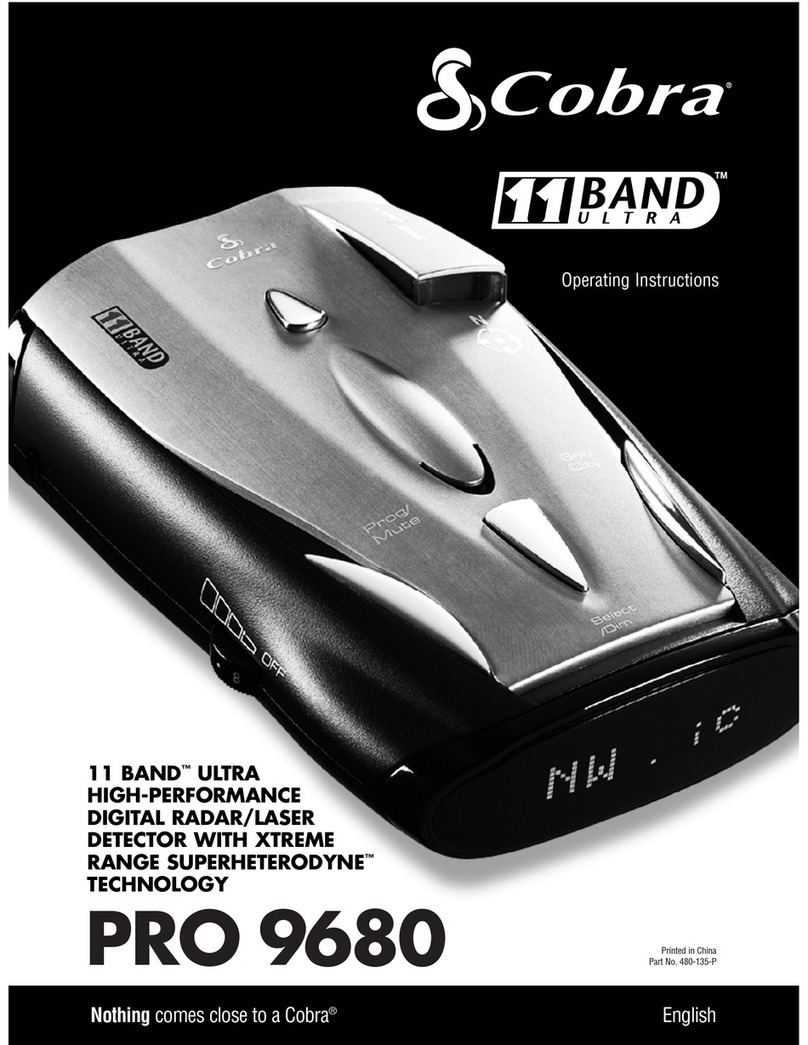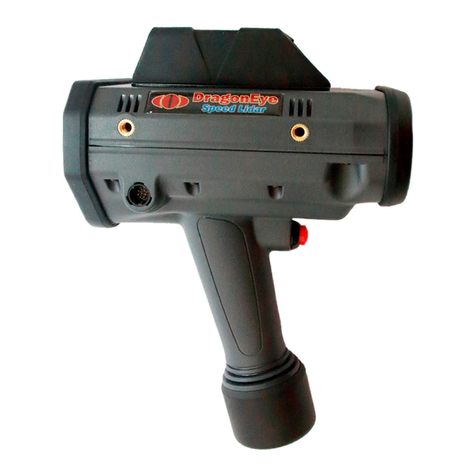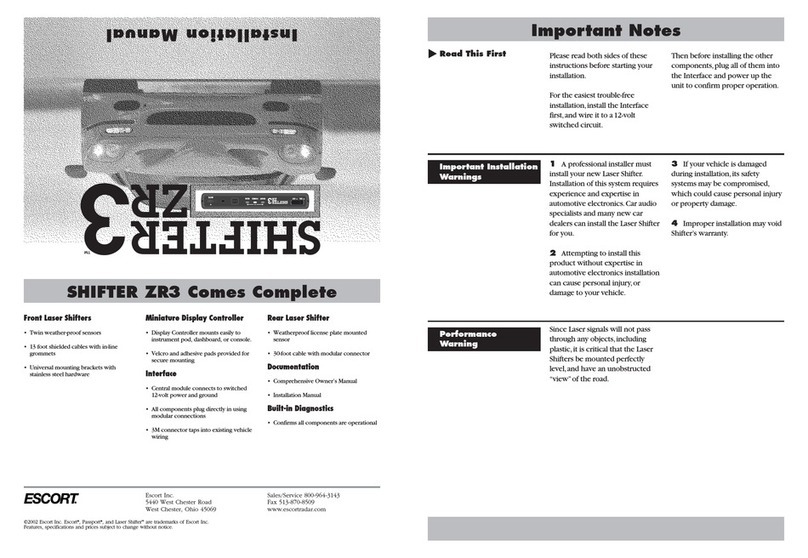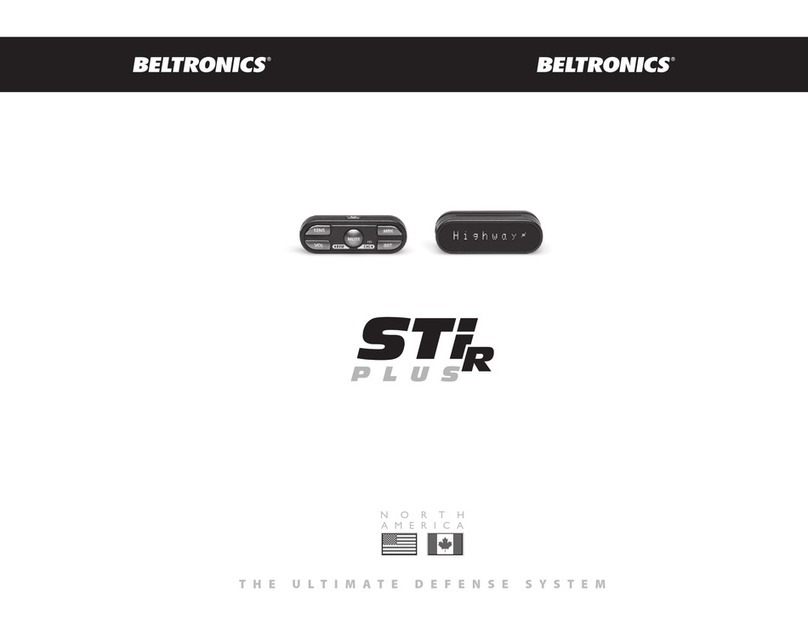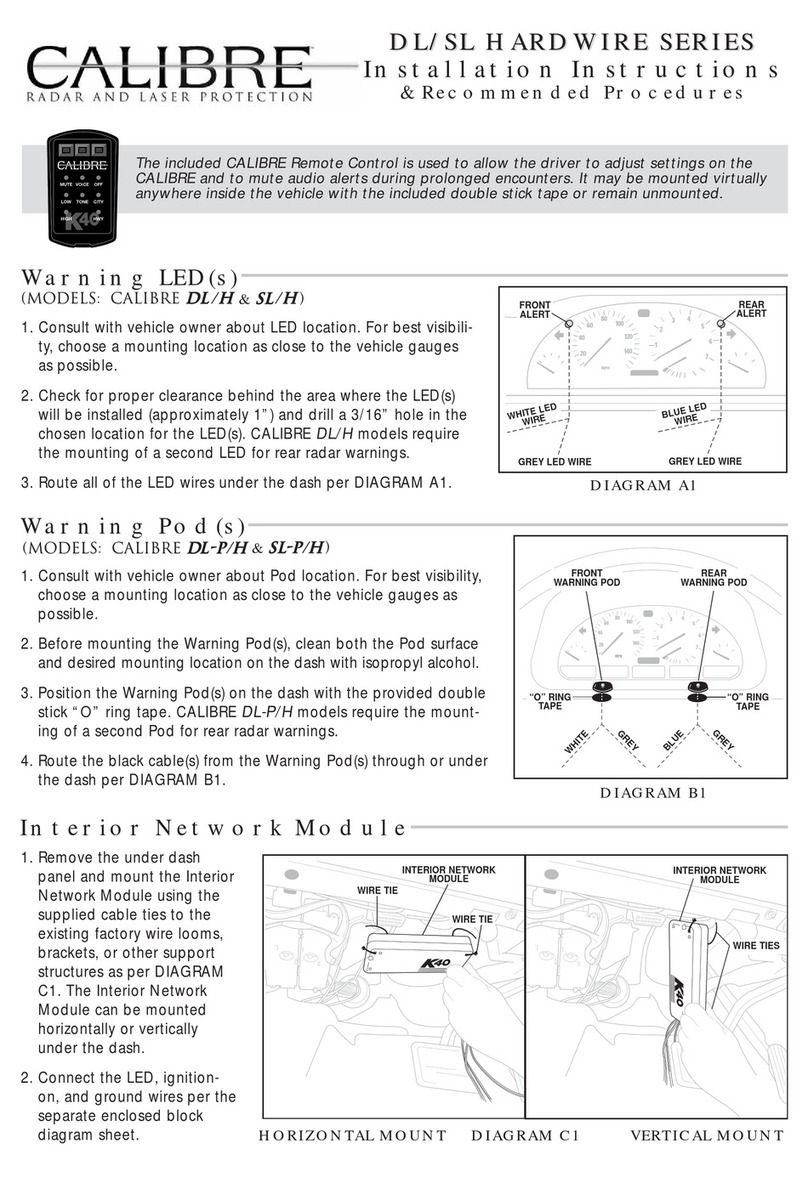MPH Industries BEE III User manual

Industries
BEE III
TM
Automatic Same Direction
TM
Traffic Radar
(Canadian Version)
Operation Manual

We at MPH Industries thank you for purchasing our equipment. We wish you
the greatest success in your speed enforcement program. We are proud that
the BEE III is a part of your department.
Copyright 2001-2013, MPH Industries, Inc.
No part of this work, covered by the copyrights hereon, may be reproduced or copied in any
form or by any means – graphic, electronic, mechanical, including photocopying, taping, or
information storage and retrieval systems – without the written permission of MPH Industries,
Inc.
BEE III, Automatic Same Direction, ASD, MPH Industries, the MPH logo, and POP are
trademarks of MPH Industries, Inc.
2

Introduction
Installation
BEE III Radar
Table of Contents
4
Range and radar placement 5
Power source 5
Fuse replacement 5
Display 6
Remote Control 8
Menu Options 11
BEE III Operational Modes
Stationary Radar 13
Moving Radar (Opposite Direction) 13
Moving Radar (Same Direction) 14
Pacing 14
Advanced Features of the BEE III
Fastest mode 15
POPTM mode 16
Stopwatch mode 17
Operational Concerns
Fastest Mode 19
Moving same direction 20
Bee III Testing Procedure 22
Interference Information and Precautions 23
Getting Started - An Introduction to the BEE III 25
BEE III Accessories 31
Quality Control, Servicing, Warranty 32
Industry Canada Certification 34
MPH BEE III Specifications 35
Operational Recommendations 39
3

Introduction
MPH Industries, Inc. designed the BEE III Doppler radar with the police officer in mind.
The radar is easy to operate and includes the performance and features required for today's
traffic environment. The BEE III is the most useful and flexible radar available; it’s a full-
featured moving radar with both fastest and directional capability.
The BEE III utilizes MPH’s patented Automatic Same DirectionTM (ASDTM) technology. ASD
allows the BEE III to automatically measure the speed of targets moving in the same direction
as the patrol vehicle, thereby eliminating the slower/faster button required by previous
generation equipment. ASDTM also allows the radar to measure the speed of targets moving in
one direction while completely ignoring targets moving in the opposite direction. In addition,
the BEE III utilizes MPH’s exclusive POPTM technology, allowing it to measure speeds while
simultaneously remaining invisible to speed measuring warning devices.
The BEE III employs state-of-the-art Digital Signal Processing (DSP) technology, which
allows the unit to have both high performance and reliability in a small package. The Digital
Signal Processor is a specialized microprocessor chip, which can perform the required
calculations for detecting patrol and target speeds efficiently.
The MPH BEE III is comprised of one or two antennas, a wired remote control (wireless
optional) and a detachable display/counting unit. MPH designed the BEE III using only the
highest quality parts. Combined with the workmanship provided by MPH`s Manufacturing
Department, the BEE III will provide years of reliable performance.
The MPH BEE III offers more than features and performance. MPH provides training
through our network of experienced field representatives. We know that our success
depends upon your success with our equipment. We are dedicated to keeping our customers
satisfied. The following pages describe the operation of the MPH BEE III radar. We can
also provide useful information on the legal aspects of traffic radar at your request.
4

Installation
Range and Radar Placement
The range or targeting distance of the radar is influenced by how it’s mounted in the police
vehicle. Heater fans are moving targets and can be detected if energy from the antenna is
reflected toward the fan. The best solution to this problem is to find a location that
minimizes this effect. To determine this location, place the unit in stationary mode, turn the
volume up and open the squelch. This enables any target or interference to be heard. If
changing fan speeds alters the audio signal, the fan is being picked up in that mounting
position; try to find a different location. Dropping the fan speed may also assist. Reducing
the range setting of the radar is another option. If you have persistent problems with fan pick
up, call the factory for suggestions specific to your particular police vehicle.
Power Source
Cigarette lighter receptacles have been the traditional source of power for traffic radar.
However, poor grounding, electronic ignition bleed over, and alternator noise can combine
to create an unacceptably high level of ambient electronic interference. In some instances, an
unusually noisy vehicle ignition/alternator can result in spurious readings and/or reduce the
targeting range of the BEE III.
To combat this it’s recommended that a shielded cable be run directly from the battery to an
auxiliary receptacle within the police vehicle. This should effectively eliminate any power
source problems.
Fuse Replacement
BEE IIIs are shipped with a fused cigarette lighter plug. The fuse is housed inside the tip of
the plug. (See arrow in below illustration.) To remove fuse: unscrew and remove the tip and
the fuse. Replacement fuses should be commonly available 2 Amp, AGC type fuses. Higher
Amperage fuses are not recommended and may violate the manufacturer’s warranty.
5

BEE III Display
The BEE III utilizes a high contrast LED display with automatic dimming.
Mode
The mode section is structured like a roadway and offers operators a pictorial view of the
radar’s functions. A large red “X” icon in the left lane informs operators that the
transmitter is in standby (off). A large green car in the right lane indicates that the
transmitter is active (on).
The operating mode of the BEE III is illustrated with the scene of a patrol car and selected
targets. In opposite direction moving mode, the scene shows an arrow in the left lane of
traffic; it is ahead of the patrol car if the front antenna had been selected and behind the
patrol car if the rear antenna was selected. In same direction moving mode, the arrows are
shown moving in the same direction as the patrol car. Moving mode is indicated by “Mov”
which appears below the middle speed display window.
In stationary mode, the mode window works similarly. Indicator arrows appear in front or
behind the patrol vehicle icon to indicate the selected antenna. In the opposite direction the
scene shows an arrow in the left lane of traffic. If the same lane of traffic is selected the
arrow in the right lane is lit. If both directions of traffic are selected, arrows in both lanes
will be illuminated. Stationary mode is indicated by “Sta” which appears below the middle
speed display window.
Speed windows
The BEE III has three windows for speed display. They are arranged by function and are
identified by the colors red, yellow and green.
The left most display is a dedicated red TARGET window. This window always displays the
strongest target’s speed, even in fastest mode. Radio frequency error conditions (rFi) are
displayed in this window.
6

The yellow middle window performs two functions; an icon located directly below the
window indicates each. If the window is being used to display a locked target speed, a
T-lock (T ) icon is lit. Only the speed of the strongest target can be locked. If the middle
window is being used to display the speed of the fastest vehicle (fastest mode), a FAST icon
is lit. General error conditions (Err) are also indicated in this window. When “rFi” is
indicated in the leftmost window, this window will display the relative strength of the signal
causing the interference.
The green window on the right side of the display shows the PATROL vehicle’s speed in
moving mode and remains blank in stationary mode. The speed displayed in this window
should correspond with the patrol vehicle’s speedometer. If a low voltage condition occurs,
“Lo” will appear in this window.
Doppler audio
The BEE III features a speaker on the front panel for Doppler audio. The BEE III's audio is
derived directly from the received Doppler signal (not synthesized) and is useful as an aid in
target identification. The loudness is proportional to the strength of the received signal and
increases as the target vehicle approaches. The pitch of the audio signal increases with
higher closing speeds. The Doppler audio always corresponds to the strongest target, even
when the radar is in fastest mode.
In stationary strongest mode (no specific direction selected) the Doppler audio heard is that
of targets traveling in both same and opposite directions. In directional stationary mode
(only same or opposite direction targets selected) the Doppler audio heard will be from the
selected direction only.
Display dimming and infrared remote sensor
A photocell located on the display panel automatically adjusts display brightness to ambient
light conditions. An infrared sensor also located on the display panel receives commands
from the optional wireless remote.
Power button
This button controls power for the BEE III radar. When the BEE III is turned off, the radar
retains all previous settings (volume, mode, etc.) with the exception of range, which defaults
to maximum. When the unit is next powered on, speed displays are blank and the unit starts
in standby mode.
7

BEE III Remote Control
The BEE III remote has two main sections of
controls. An upper section with raised rubber
buttons and a lower section with flat membrane
buttons.
Operating mode keys (Upper section)
The most commonly used buttons are located at the
top of the remote. They are raised rubber and are
contoured so that the operator’s thumb is cradled in
the center of a five-button cluster. This design
facilitates easy control of the radar’s operating
modes while at the same time, allowing operators to
keep their eyes on the road. All keys are backlit for
night time use.
Front: Selects Front antenna.
Rear: Selects Rear antenna.
Stndby: Places radar into Standby (transmitter-off).
Opp: Places radar into Opposite direction mode.
Same: Places radar into Same direction mode.
Lock: Locks Target speed in lock window.
Fastest: Activates Fastest vehicle mode.
8

Other buttons (Lower section)
The lower section of the remote contains flat membrane-type buttons that are embossed
around their edges to make them easy to identify by feel.
Some buttons contain two text colours. The red text is the default function; pressing the
button by itself will cause it to perform that function. The function in blue text is initiated by
first pressing the blue “2nd F” button.
Mov/Sta: Toggles the radar between moving and stationary operating modes.
Stopw: Activates stopwatch mode (“2nd F” button must be pressed first).
Test: Manually initiates a radar self-test. The radar will momentarily illuminate all displays
and icons followed by simulated speeds. If no problems are detected it will return to the
previous mode of operation. If a problem is found the radar will display “Err” (error) and
cease the speed measurement process.
POP
Note: Never activate Test during target acquisition.
The radar also performs internal self-checks during normal operation (initiated
automatically). If operating correctly a double beep will be heard or alternatively,
“Err” (error) if a problem is found.
Pat Bl: When in Standby mode, pressing the “Pat Bl” button will clear the patrol speed
display. (“2nd F” button must be pressed first). Pressing “Pat Bl” a second time will
cause the locked patrol speed to reappear.
Low/Hi: Selects the City or Highway filter and determines the low end patrol speed. “Ci”
(City mode) or “Hi” (Highway mode) appears in the patrol window while in
Standby.
– Once pressed a “P” appears in the middle window. POP + must be selected to
POP
enter into POP mode. It also functions with the “Menu” button. If a menu
selection has been made it will decrease the setting.
Menu: Facilitates the selection of modes and settings that do not have individual buttons on
the remote. For further information see the Menu section of this manual.
– Direct entry into POP mode. It also functions with the “Menu” button. If a
menu selection has been made it will increase the setting.
9

2nd F: Selects the secondary “blue” function of a button instead of the red primary
function. “2nd” appears in the middle window when pressed. Pressing a second
time causes “2nd” to disappear and allows the radar to select the primary “red”
function.
Backlt: This button performs no function for wired remote controls.
10

Menu Options
One press of the
“
Menu
”
button
–
Adjust Audio Volume
Audio volume has 7 available settings (0 through 6, with 0 being “mute”). During volume
adjustment, “A” is displayed in the middle window of the radar followed by the current
setting.
MPH sets the initial level at 4. On subsequent power-ups the BEE III retains the last known
volume setting (when powered off).
Pressing the “—” button lowers the volume one level; pressing the “+” button raises the
volume one level. Pressing the “Menu” button after making an adjustment returns the radar to
its normal operating mode. Pressing the “Menu” button without making an adjustment causes
the radar to move to the next menu setting.
Note: Operators are required to utilize Doppler audio at all times to assist with both target
identification and tracking history.
Two presses of the
“
Menu
”
button
–
Adjust Squelch
The squelch has two settings: on and off. Squelch “on” causes the radar to produce an audio
tone only when a target is present, while Squelch “off” causes the Doppler return signal to be
amplified at all times. During squelch adjustment, “S” is displayed in the middle window of
the radar, followed by the current setting (“n” for on and “f” for off).
On its initial power-up the squelch is “on”. On subsequent power-ups the BEE III retains the
last known squelch setting (when powered off).
Pressing either the “—” button or the “+” button causes the radar to toggle between Squelch
“on” and Squelch “off”. Pressing the “Menu” button after making an adjustment returns the
radar to its normal operating mode. Pressing the “Menu” button without making an
adjustment causes the radar to move to the next menu setting.
11

Three presses of the
“
Menu
”
button
–
Adjust Dynamic Stationary Mode
In dynamic stationary mode, the radar automatically toggles itself between moving and
stationary mode dependant upon vehicular motion.
Dynamic stationary mode is automatically turned “on” if the radar detects a speedometer
interface during power-up. Operators are given the option to turn this feature “on” or “off”.
The setting is indicated on the radar menu by the letters “dS”. Dynamic stationary mode can
be turned “on” by pressing the “+” button (“dSn”) and can be turned “off” by pressing the “—
“ button (“dSf”). Dynamic stationary mode is available only if the vehicle speedometer
interface cable is connected to the BEE III radar.
Note: Earlier models do not contain this menu option.
Four presses of the
“
Menu
”
button
–
Adjust Range
The BEE III radar has 7 available range settings (1 through 7). Adjustment affects the radar’s
sensitivity and not the transmitted power. During range adjustment, “r” is displayed in the
middle window of the BEE III followed by the current setting.
Upon initial power-up the range defaults to maximum (7).
Pressing the “—” button decreases the range one level; pressing the “+” button increases the
range one level. Pressing the “Menu” button after making an adjustment returns the radar to
its normal operating mode. Pressing the “Menu” button without making an adjustment
causes the radar to move to the next menu setting.
Five presses of the
“
Menu
”
button
–
Enter POP mode
POP mode is initiated by pressing the “Menu” button five times, until a “P” appears in the
middle window. POP can also be turned on by pressing the “+” button and can be turned
off by pressing the “—“ button. Once activated the middle speed window will display
“POP”.
Note: A sixth press of the “Menu” button cycles back to audio volume adjustment.
12

BEE III Operational Modes
Practical use of the BEE III
The BEE III enables the operator to choose a variety of operational modes including
Stationary, Moving (opposite or same direction) and Pacing.
A. Stationary Radar
When operated in stationary mode (patrol vehicle stopped), the BEE III radar allows the
operator to monitor traffic driving towards or away. This type of operation is usually
carried out in areas of high-speed traffic or complaint. In stationary mode the patrol
window remains blank.
ASDTM technology enables the operator to monitor traffic travelling in the same
direction as the patrol vehicle, in the opposite direction or in both directions
simultaneously. This selection can be made from either the front or rear antenna. The
operator can also monitor the fastest target traveling in the selected direction in addition
to the strongest target.
B. Moving Radar (Opposite Direction)
The BEE III radar monitors the speed of both approaching and receding motor vehicles
and displays in the target window.
Patrol vehicle speed is continuously displayed so operators can compare it to the
speedometer reading. If these speeds correspond, the operator is assured that the target
reading is correct following the completion of a proper tracking history.
In opposite direction mode care should be taken by the operator to recognize that the
violator is traveling above the posted limit. Proper identification of the violating motor
vehicle must take place and at the time of speed determination, the patrol vehicle's
speed must correspond with the reading on the speedometer. If these steps are taken,
the operator is confident that the radar displayed a true and accurate target vehicle
speed.
13

C. Moving Radar (Same Direction)
Same direction mode enables the BEE III to track targets that are moving either faster or
slower than the patrol vehicle. This mode is best used in light traffic where visual target
identification is less difficult.
The BEE III incorporates an advanced, patented technology called Automatic Same
DirectionTM (ASDTM) processing. This allows the BEE III to determine the absolute
speed of a same direction target without requiring operator input. In other words, same
direction operation is AUTOMATIC thus simplifying same direction operation.
Target vehicles traveling near or at the same speed as the patrol vehicle will not be
sensed by the BEE III as they generate a minimal to non existent Doppler shift.
While operating in same direction mode, an 8 kph differential (faster or slower) must
exist between the patrol and target before target readings are displayed. Operators must
keep this in mind because the closest motor vehicle may not be the target speed
displayed. In this mode only, target speed range is limited to ±70% of the patrol speed.
The range or sensitivity of the BEE III is greatly reduced in same direction mode. This
reduction eliminates more distant targets thus making target identification easier.
D. Pacing Radar
The BEE III provides the operator with an accurate means of pacing targets. In this
mode the radar essentially functions as a calibrated speedometer utilizing the patrol
display.
14

Advanced features of the BEE III
The following modes are very useful features assisting in target identification. Being
somewhat more complex, it’s recommended that operators become familiar with the more
conventional modes before operating these advanced features.
1. Fastest Mode
Fastest mode is available in all modes of operation. Pressing the “Fastest” button on the
remote control will initiate a search for any motor vehicle that is faster than the strongest
target. Activation of this mode will be indicated on the front panel, as the "FAST" icon
below the middle window will be illuminated.
The display's middle window will show the speed of the fastest target that’s moving
faster than the strongest vehicle, if such a target exists. Otherwise the window will be
blank showing that the radar is looking for a faster target but there isn't one within range
of the radar. The BEE III will remain in fastest mode until the fastest button is pressed
again or until a target speed is locked. Once pressed the radar will return to normal
(strongest target) radar mode.
The middle speed window will display the speed of the fastest target, while the normal
target window continues to display the strongest target. If the strongest target is the
fastest target within the range of the BEE III, the fastest window will be filled with
underscores. The Doppler audio and the mode window will continue to track the
strongest target when the radar is in fastest mode.
Locking a target while the BEE III is in fastest mode will lock the strongest target. The
BEE III will not allow speeds displayed in the fastest window to be locked.
In stationary mode, the radar only looks for faster targets in the selected direction, either
Same or Opposite. If the radar is being operated in both-direction stationary mode, the
radar only looks for faster targets moving the same direction as the strongest target is
travelling. It therefore may not show the speed of the absolute fastest target in this case. If
you observe a faster target that you want to observe, it is recommended that you place the
radar in directional stationary mode and select the direction in which that particular motor
vehicle is travelling. Page 19 should be referenced for more information.
15

2.POPTM Mode
This exclusive MPH feature, utilizes the latest in technology to thwart the efforts of
speeders who have purchased illegal speed measuring warning devices. Using the POP
mode, an operator can perform quick, accurate speed checks without alerting
approaching motor vehicles. Once a speeding vehicle has been detected, operators can
then switch to conventional mode, locking in the target while conducting a proper
tracking history.
With conventional radar, activating the front or rear antenna activates the transmitter.
Under ideal conditions speed readings can be obtained in approximately 1/2 second.
Most warning devices today can easily recognize this, alerting all so equipped motor
vehicles within several kilometers.
POP mode is initiated by either pressing the “POP +” button or by pressing the “Menu”
button five times. The operator must then press the “+” button to turn the mode on. The
middle speed window will display “POP”.
Once POP mode has been initiated, a momentary press of the “Front” or “Rear” antenna
button will activate the transmitter for a brief instant, long enough to acquire a target.
This pulse or burst of microwave energy is so short it’s undetectable by most speed
measuring warning devices. If the displayed speed is of interest, the operator simply
presses the corresponding antenna button once more and the radar will commence
conventional operation. “POP” will disappear from the middle speed window. If the
antenna button is not pressed again, the transmission is limited to the single pulse and
the BEE III remains in POP mode awaiting the next target.
To lock in a speed, the radar must be in conventional or continuous transmit mode. POP
mode readings produce a reference speed only and should not be utilized for
enforcement purposes (no Doppler audio). Speeds displayed as a result of POP pulses
cannot be locked. This has been implemented to ensure BEE III operators conduct a
proper tracking history prior to locking in a speed reading.
POP mode can be exited in several ways. One such method is to place the radar into
continuous transmit mode as described above. Another technique is by pressing the
“Menu” or “Standby” buttons on the remote. When you exit Pop mode, “POP”
disappears from the middle window.
Effective use of POP mode
Speed measuring warning devices are most effective on long stretches of roadway with
minimal traffic. In this situation, each time the speed is measured on a passing car all
motor vehicles with detectors are alerted. This is a perfect application for POP mode.
POP mode is best utilized at shorter ranges with some separation between targets.
16

Degree of effectiveness
When using POP mode most radar detectors will detect nothing even at point blank
range. A small percentage will detect it when pulses are repeated quickly (less than a
few seconds between pulses). An even smaller percentage will give a minor alert,
similar to what door openers and other interference sources cause. POP mode is
invisible in most cases, but always substantially less detectable than conventional radar
mode.
When possible it’s recommended operator’s sample a variety of speed measuring
warning devices to sample POP mode’s effectiveness.
A note of caution:
Offence notices should not be issued based solely on information derived from a single
POP burst as no tracking history has been developed. The radar should be placed into
continuous transmit mode by pressing the corresponding antenna button while the POP
speed is still displayed. Operators must conduct a proper tracking history.
3. Stopwatch Mode
Stopwatch mode makes use of precision counters from within the BEE III unit to
measure motor vehicle speed without microwave transmission. This function allows an
operator to measure the amount of time it takes a motor vehicle to travel a known
distance and then performs a speed calculation utilizing the following formula:
Speed = (distance traveled) ÷ (time required to travel that distance)
To enter stopwatch mode, operators must press the blue “2nd F” button on the remote
control followed by the “Stopw” button. “.0” will be present in the Target window and a
number in the Patrol window. The Target window is the time window and the Patrol
window shows the distance that the measurement will be performed over in meters.
To utilize this mode, operators must locate an area over which they wish to monitor
speed. This area will require two distinct points of reference or landmarks, both clearly
visible from the patrol car so that the timer can be accurately started and stopped. An
accurate distance between the landmarks is essential.
To achieve the best accuracy in stopwatch mode, the measurement time for a motor
vehicle to traverse the distance selected should be at least 10 seconds. To accomplish
this, landmarks in the city should be at least 100 meters apart increasing to several
hundred meters in the country.
17

Operators must next enter into the radar how far apart the landmarks are. Stopwatch
mode defaults to a distance of 100 meters. Each press of the “+” button will increase the
distance by 1 meter and each press of the “—” button will decrease the distance by 1
meter. Similarly each press of the “Same” button increases the distance by 10 meters
and each press of the “Opposite” button decreases the distance by 10 meters. Finally,
each press of the “Front” button increases the distance by 100 meters, while each press
of the “Rear” button decreases the distance by 100 meters.
The internal timer is started and stopped by pressing the “Lock” button. To measure a
motor vehicle’s speed, operators must press the “Lock” button when the target vehicle
passes the first landmark. When it has reached the second landmark, the “Lock” button
must be pressed again. This causes the timer in the Target window to freeze with the
calculated speed displayed in the middle window. Since this is a locked target speed, the
T-lock indicator will be illuminated under the middle speed window.
To measure the next motor vehicle press the “Lock” button again. This clears the
previous speed and resets the time to zero. To exit stopwatch mode, press the “Menu” or
“Mov/Sta” button.
18

Operational Concerns
Fastest Mode
Historically traffic radar displayed the strongest reflecting target. Case law has centered on
the ability of the radar operator to confidently identify whose motor vehicle is associated
with that particular speed. Due to technical limitations, it was relatively simple for analog
radars to process this method.
Advancements in technology have enabled modern DSP radars, such as the BEE III, to
process multiply targets simultaneously. Unfortunately no practical method exists to
communicate such information to an operator like air traffic control radar does.
Fastest mode gives the operator an opportunity to view one other target in addition to the
strongest. In this mode, the BEE III considers all possible targets within range (there may be
several) and display the absolute fastest.
While speed readings displayed in fastest mode are as accurate as those displayed in the
target window, visual identification of the offending vehicle can be more difficult. Fastest
mode is intended to be utilized as a method of gathering additional information about a
specific scenario.
Operation in fastest mode
Important points to remember when using the fastest mode:
1. In any mode, the BEE III’s target window always displays the strongest target in the
selected direction of travel. The speed displayed in the target window is the only speed
that may be locked.
2. If the strongest target is the fastest target, the speed will not be duplicated in the fastest
window. This serves as an alert to the operator that the strongest is the fastest, and its
speed may be locked. Often a speed will appear in the fastest window first and then shift
to the target window when the previous strongest target exits the radar beam. In these
situations, the fastest mode provides more tracking information and additional time to
observe or lock the target.
3. In some scenarios, such as a car passing a large truck, the fastest target, the car, will
never be the strongest reflection.
19

4. While visual identification of the strongest target is straight forward, identification of the
fastest target requires more operator attention. In the above scenario when a car passes a
large truck, the fastest window may display the speed of the car or alternatively, that of a
faster motor vehicle within range of the radar. When in fastest mode operators must be
aware of all potential targets. BEE III operators can never assume that the fastest target
is the second strongest reflector.
5. In fastest mode the BEE III’s range setting defaults to maximum. Changing the range or
sensitivity will have no effect on fastest targets.
Moving Same Direction Mode
The BEE III allows the tracking of targets moving in the same direction as the patrol vehicle.
This mode can be slightly more difficult to operate especially in heavy traffic where visual
target identification is not as easy.
Operation of moving same direction mode
Same direction moving mode is selected by pressing the “Same” button on the remote
control when the radar is in moving mode.
The BEE III’s ASDTM technology allows it to determine the difference between a target
traveling faster or slower than the patrol vehicle.
With ASDTM, a target travelling 10 kph slower than the patrol vehicle and a target travelling
10 kph faster than the patrol vehicle do not produce the same signal at the radar antenna. It is
true that the Doppler tone generated in the speaker by each target corresponds to 10 kph.
However the signals present within the antenna are different.
When operating the front antenna, a target moving slower than the patrol vehicle is actually
getting nearer the patrol vehicle and produces a return signal that is at a higher frequency
than the transmitted signal. Conversely a target moving faster than the patrol vehicle is
moving away from the patrol vehicle and produces a return signal that is at a lower
frequency than the transmitted signal. When operating the rear antenna, the radar functions
in a similar manner.
ASDTM technology can tell the difference between these two frequencies (whether it’s
higher or lower than the transmitted signal). The BEE III automatically determines if the
target is approaching or receding and calculates the proper target speed.
20
Other manuals for BEE III
1
Table of contents

